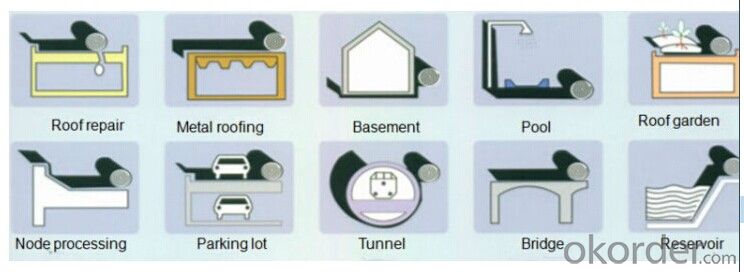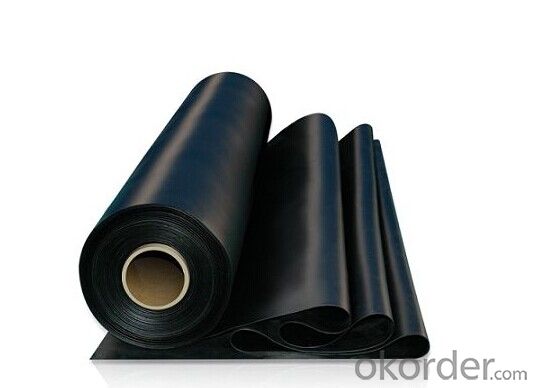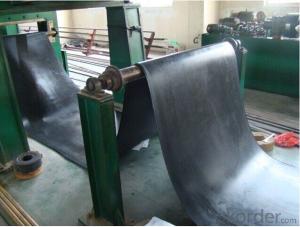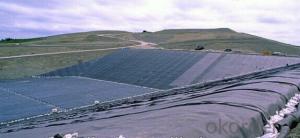EPDM Roof Waterproof Membrane with 1.2mm/1.5mm/2.0mm
- Loading Port:
- Qingdao
- Payment Terms:
- TT OR LC
- Min Order Qty:
- 2000 m²
- Supply Capability:
- 300000 m²/month
OKorder Service Pledge
OKorder Financial Service
You Might Also Like
EPDM Waterproof Membrane
Introduction for EPDM Waterproof Membrane
EPDM waterproof membrane is made from ternary ethylene-propylene rubber. With the best performance among high polymer waterproof materials, EPDM is of exceptional elasticity and will not split or crack under normal building movement.
Features for EPDM Waterproof Membrane
1.Excellent anti-aging performance, service life can reach 50 years;
2.High elongation, high tensile strength, heat treatment size change small;
3.Plant root penetration resistance is good
4.Good low temperature flexibility
5.Application is convenient, overlapping is firm and reliable, no environmental pollution;
6. Resistance to chemical corrosion, can be applied to special places;
7.Maintenance is convenient, the cost is low
Application for EPDM Waterproof Membrane
1) Roofs, Basement, Toilet
2) Industrial and civil building waterproofing
3) Geo-synthetic liner for swimming pool, channels, irrigation system
4) Especially suit for projects with high requirements in durability, anti-corrosion and deformation

Specification for EPDM Waterproof Membrane
Item | Thick(mm) | Width | Length(m) | Color |
Spe | 1.0—2.0 | 1.2m/2m/3m/4m | 20 | Black |
Deviation | -1 +15 | --1 | Multicolor |
Technical Sheet for EPDM Waterproof Membrane
EPDM Waterproof Membrane ASTM Standard : D-7465 | ||||
Property | Test Method | Units | Mininum ASTM | |
D-7465 | ||||
Sl | Eng | |||
Specific Gravity | ASTM D-792 | gm/cc | 1.1 | 1.1 |
Unit Weight | ASTM D-751 | kg/m2 | 1.3 | 0.27 |
Thickness Type 1 | ASTM D-412 | mm(in) | 1.02 | 0.04 |
Tensile Strength. Die C | ASTM D-412 | Mpa(psi) | 9 | 1305 |
Ultimate Elongation,Die C | ASTM D-412 | % | 300 | 300 |
Tear Resistance,Die C | ASTM D-624 | Kn/m(lbf/in) | 26.27 | 150 |
Puncture Resistance | ASTM D-4833 | N(lbs) | 133 | 30 |
Shore A Durometer | ASTM D-2240 | 65-10 | 65-10 | |
Ozone Resistance | ASTM D-1149 | No Crack | No Crack | |
Multiaxial Elongation | ASTM D-5617 | % | 100 | 100 |
Heat Aging 28 days at 240 degrees | ASTM D-573 | |||
Tensile Strength, Die C | ASTM D-412 | MPa(psi) | 8.3 | 1205 |
Ultimate elongation, Die C | ASTM D-412 | % | 200 | 200 |
Tear Resistance, Die C | ASTM-624 | Kn/m(lbf/in) | 21.9 | 125 |
Accelerated Aging Xenon Arc | ASTM G-155/G-151 | Pass | Pass | |
Brittleness Point | ASTM D-2137 | -45 °C | -49 °C F | |
Water Absorption | ASTM D-471 | % | +8,-2 | +8,-2 |
Water Vapor Permeability, max | ASTM E-96 | Permils | 2.0 | 2.0 |
Linear Dimensional Change,max | ASTM-D-1204 | % | +/-1.0 | +/-1.0 |
Chronic Toxicity Screening | EPA/600/4-89/001 | Method 1000.0 | Pass | Pass |


FAQ:
Can you produce 4m width?
Yes, no problem for us. We have four bases in China, largest one in this field.
How many quantity in one 20'' container for 1.2mm and 1.5mm?
480rolls, 11520m2 for 1.2mm and 400rolls, 9600m2 for 1.5mm
Can you provide free samples?
Yes, our samples are free, but express fees usually on buyer's account.
- Q:Can a waterproofing membrane be used on stainless steel surfaces?
- Indeed, stainless steel surfaces can benefit from the application of a waterproofing membrane. Stainless steel, a resilient and non-corrosive material widely utilized across different industries, is not impervious to water damage or corrosion, particularly in severe conditions. By applying a waterproofing membrane onto stainless steel surfaces, an extra shield against moisture is established, effectively warding off potential water damage, rusting, and corrosion. To guarantee optimal adhesion and durable protection, it is crucial to ensure the compatibility of the waterproofing membrane with stainless steel and its correct application.
- Q:Can a waterproofing membrane be applied on top of existing surfaces?
- Yes, a waterproofing membrane can be applied on top of existing surfaces. However, it is important to ensure that the existing surface is clean, dry, and free from any contaminants or loose materials before applying the membrane. Additionally, proper surface preparation and application techniques should be followed to ensure the effectiveness and longevity of the waterproofing system.
- Q:Can a waterproofing membrane be used on asphalt roofs?
- Yes, a waterproofing membrane can be used on asphalt roofs. In fact, it is a common practice to apply a waterproofing membrane on asphalt roofs to enhance their durability and protect them from water damage. The membrane is typically made of a synthetic material, such as modified bitumen or EPDM, which creates a barrier against water infiltration. This helps prevent leaks and extends the lifespan of the asphalt roof. Additionally, the waterproofing membrane can also provide added insulation and energy efficiency benefits to the building. However, it is important to ensure that the specific waterproofing membrane chosen is compatible with asphalt and meets the necessary industry standards for performance and durability. Consulting with a professional roofing contractor or manufacturer is recommended to determine the most suitable waterproofing membrane for asphalt roofs.
- Q:Can waterproofing membranes be used on concrete slabs?
- Yes, waterproofing membranes can be used on concrete slabs. These membranes are designed to provide a protective barrier against water infiltration and can effectively prevent moisture from seeping into the concrete.
- Q:Can a waterproofing membrane be used on both horizontal and vertical surfaces of a structure?
- Yes, a waterproofing membrane can be used on both horizontal and vertical surfaces of a structure. Waterproofing membranes are designed to create a barrier against moisture and are commonly used in various applications such as roofs, basements, foundations, balconies, and walls. They are flexible and can adapt to different surface orientations, making them suitable for both horizontal and vertical installations. The membrane's flexibility allows it to be easily applied and adhere to different surfaces, providing effective protection against water infiltration and potential damages caused by moisture. Whether it is applied on a horizontal surface like a roof or a vertical surface like a wall, a waterproofing membrane can help maintain the integrity and longevity of a structure by preventing water penetration and potential water-related issues.
- Q:What are the requirements for frost resistance of basement floor polymer waterproofing membranes?
- Requirements are, when the material quality testing, the ground temperature must meet the requirements of national norms.
- Q:Does a waterproofing membrane have any impact on the thermal performance of a structure?
- Yes, a waterproofing membrane can have an impact on the thermal performance of a structure. A waterproofing membrane is typically used in buildings to prevent water infiltration, which can cause damage to the structure over time. By creating a barrier against moisture, the membrane helps to maintain the integrity of the building envelope and protect against potential leaks or water damage. In terms of thermal performance, a waterproofing membrane can help to improve insulation by reducing the amount of heat transfer through the building envelope. By preventing moisture from entering the structure, the membrane also helps to prevent the formation of condensation, which can lead to mold growth and further damage to the building materials. Furthermore, some waterproofing membranes are designed with additional insulation properties, such as foam or reflective coatings, which can further enhance the thermal performance of a structure. These membranes help to reduce thermal bridging and improve energy efficiency by minimizing heat loss or gain through the building envelope. It is important to note that the impact of a waterproofing membrane on the thermal performance of a structure can vary depending on the specific type of membrane, its installation, and the overall design of the building. It is advisable to consult with a professional architect or engineer to determine the most suitable waterproofing solution that meets both the water resistance and thermal performance requirements for a particular structure.
- Q:Can a waterproofing membrane be used for military facilities?
- Indeed, military facilities can benefit greatly from the utilization of a waterproofing membrane. Designed specifically to create a protective barrier against water infiltration, these membranes play a crucial role in safeguarding structures and equipment from potential harm. In military settings like barracks, hangars, and command centers, the implementation of a waterproofing membrane guarantees the preservation of the building envelope's integrity. This, in turn, shields it from moisture intrusion, mold growth, and potential structural damage. Moreover, the use of a waterproofing membrane further enhances the facility's durability and longevity, ultimately reducing the need for costly repairs and maintenance in the long run. Consequently, the application of a waterproofing membrane offers immense advantages to military facilities, ensuring a resilient and robust infrastructure capable of withstanding diverse environmental conditions.
- Q:How does a waterproofing membrane handle structural cracks?
- A waterproofing membrane is designed to handle structural cracks by providing a barrier that prevents water penetration through the cracks. It acts as a protective layer, sealing the cracks and preventing any moisture from seeping into the underlying structure. This helps to maintain the integrity of the waterproofing system and ensures long-term protection against water damage.
- Q:Can a waterproofing membrane be used on drywall surfaces?
- Indeed, it is possible to utilize a waterproofing membrane on surfaces composed of drywall. Drywall, being a material with porosity, is prone to damage caused by moisture, particularly in areas that are inclined to high levels of humidity or exposure to water, such as bathrooms or basements. The application of a waterproofing membrane on drywall aids in the creation of a protective barrier against moisture, thereby preventing the infiltration of water and potential harm. This membrane can be implemented either as a liquid coating or as a sheet membrane directly applied onto the drywall surface. It is of utmost importance to adhere to the instructions provided by the manufacturer and guarantee a proper installation, as this will result in effective waterproofing and safeguard the drywall from issues associated with moisture, such as the growth of mold, mildew, and rot.
1. Manufacturer Overview |
|
|---|---|
| Location | |
| Year Established | |
| Annual Output Value | |
| Main Markets | |
| Company Certifications | |
2. Manufacturer Certificates |
|
|---|---|
| a) Certification Name | |
| Range | |
| Reference | |
| Validity Period | |
3. Manufacturer Capability |
|
|---|---|
| a)Trade Capacity | |
| Nearest Port | |
| Export Percentage | |
| No.of Employees in Trade Department | |
| Language Spoken: | |
| b)Factory Information | |
| Factory Size: | |
| No. of Production Lines | |
| Contract Manufacturing | |
| Product Price Range | |
Send your message to us
EPDM Roof Waterproof Membrane with 1.2mm/1.5mm/2.0mm
- Loading Port:
- Qingdao
- Payment Terms:
- TT OR LC
- Min Order Qty:
- 2000 m²
- Supply Capability:
- 300000 m²/month
OKorder Service Pledge
OKorder Financial Service
Similar products
New products
Hot products
Related keywords




























